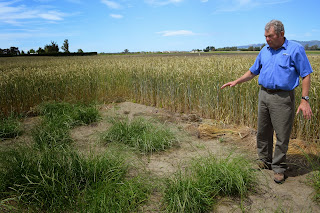Friday was an early start and a fine end to the week in the Canterbury area. We met up with farm agronomist Roger Lasham who works, part time for Turley Farms and runs his own agronomy service as well. Turley farms is a very large farming operation growing around 15 different crops and producing many seeds for export to Europe. Many of the crops are spring sown with winter cover crops planted to over-winter the farms dairy cows on. Crops grown include; winter wheat, potatoes, carrots, red beet, bulb onions, clover seed, rye grass, oilseed rape, vining peas, and sweet corn. The farm is one of the few business's in the area to use variable rate P&K and almost more importantly lime. A great example was when Roger first took on the agronomy a field had a recommendation for 240T of lime, based one one sample. After VR sampling and plans being drawn up, a total of 14t was applied!
The farm uses a lot of pivot irrigation and is on elf the largest agricultural users of electricity in the area. To monitor the requirement moisture probes are used. The probes have a trace wire buried in the ground at varying depths to assess the availability and requirement of water. This is then used to schedule the irrigation pivots. Each span of the pivot costs about $20,000 and will water 56m each.
White clover is also grown. The crop enables livestock to be fattened over the winter months and provides a great nitrogen fixing break into the rotation. One of the aspects of the agriculture I have found here is the wide range of crops grown. Wheat is almost a break crop from rye grass, clover and winter forage production. Much of this cropping is stimulated by the profitability of the diary industry, filtering money down to the arable farmers who can make some good money by growing stock over the winter months. Weaned calves for instance can generate $8/week and bigger cattle over a year old can bring in over twice that. We had a really great trip around so thanks Roger for your time.
After a very quick lunch we met up with Murray Kelly from PGG Wrightson, who is a program leader in their seed production research. Murray has over 30 years experience so it was a real pleasure to spend a few hours in his company on a very hot Friday afternoon. The company produces seed through local farmers to sell all over the world. Seeds grow include Kale, Forage Rape, Turnips, Swedes, Leaf Turnips, Chicory, Plantain, Perennial and Italian Rye grass and numerous clovers.
In the picture above Murray shows us about the individual rye grass seeds that have been planted to assess their characteristics. Those selected will be multiplied up for more testing and a sample put into longer term, on site storage. The cold store runs at about 3.5 degrees with a relative humidity of 35%. Seeds will stay undamaged and with 98% germination in these conditions for over 25 years.
Out in the field we met Steve Shorter who is one of the wheat breeders based at the site. Steve was selecting individual ears from 40m lengths of planted wheat. Out of this mixed population Steve will select no more than 100 ears, based on height and disease resistance (no fungicides or water). These ears will then be multiplied up and put into the breeding program to assess them for agronomy characteristics and yield. Some key things I learnt today about New Zealand farmers is their flexibility to follow the market, helped by the climate and their ability to specialise in changing crops and practises. I found probably the longest ear of wheat I have ever seen which Steve dismissed as it would probably cause the plant to lodge!
Later that evening Tom and I headed off over the Rakaia gorge with Mark Scott, a local Cross Slot contractor to look at one of the machines he has hired in, drilling fodder Kale high in the hills, after pasture to fatten deer on through the winter. The grass had been sprayed off for about 4 weeks prior to the drill planting the forage crops. It would have been planted earlier but Mark has been very busy. His two 3.2m (roughly) machines drill about 3,000Ha/year with much of the being planted in the spring. The backdrop to the tractor working was stunning so forgive me if I post a few shots! We headed back to the Blue Pub, where we had a couple of beers and a fine steak. We also bumped into a couple of Harper University students working out here one of whom turned out to be Will Odam who's fathers contracting business spreads the poultry manure for us back at home; small world!








No comments:
Post a Comment